One of the world’s last untouched places is right here in Australia
By Sue Williams
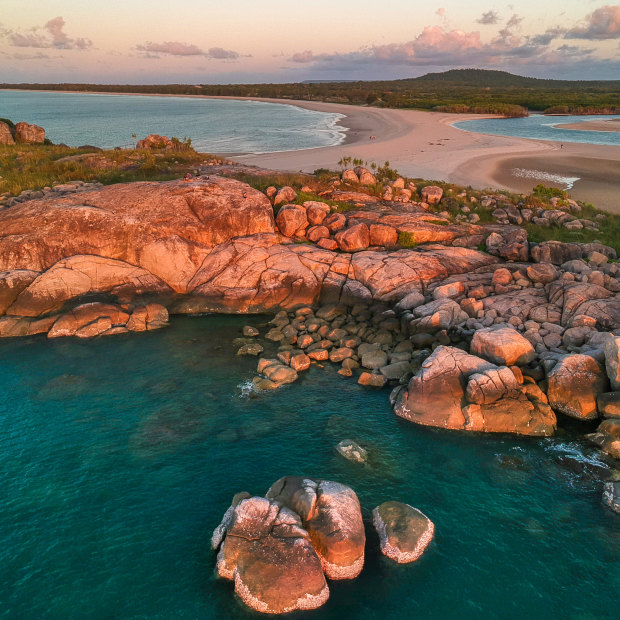
Arnhem Land is a unique region of Australia that’s almost all Aboriginal freehold land, stretching from the Gulf of Carpentaria in the east to Kakadu National Park in the west.Credit: Tourism NT/Mark Fitzpatrick
We’re sitting on the white sands of one of Australia’s most glorious beaches, gazing out at the turquoise waters of the Arafura Sea, when a group of First Nations women elders approach.
They’re carrying a big black tureen filled with leaves from a certain local bush that have been crushed and boiled over a campfire, and ask if any of us have aches and pains we’d like healed. They’re almost bowled over in the rush.
Then, over the next hour, these Yolngu women of the Gumatj clan – a group which includes Dhopiya, the sister of late great Yothu Yindi singer-songwriter and former Australian of the Year Mandawuy Yunupingu – scoop up great armfuls of sloppy Butjiringaning leaves and massage the aloe vera-type gooey extract into shoulders, arms, knees … anywhere that hurts.
Or did hurt.
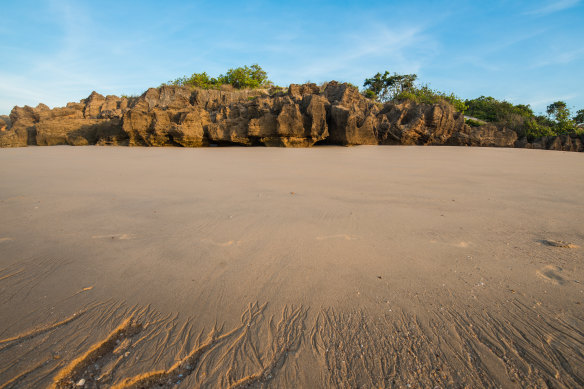
Cape Wirrwawuy at sunset.Credit: Getty Images/iStockphoto
My shoulder had been throbbing after a bad twist two days before. I can no longer feel it. Jeff, a share-trader from Adelaide, is similarly taken aback. “My knee was so stiff before, but this made it so much better. That’s pretty amazing.”
The traditional healers grin. They dance and sing for us, when we arrive at their Wirrwawuy Beach, five kilometres from Nhulunbuy, the biggest town in north-east Arnhem Land, more than 1000 kilometres east of Darwin and 730 kilometres east-north-east of Katherine.
Dressed in multi-coloured dresses – in homage to their rainbow serpent totem – and to the hypnotic sound of three musicians on clapsticks and a didgeridoo, they are joined by their menfolk in ceremonial dance and song about looking for waterholes, digging for yams and hunting.
Another tells the ancient legend of asking a black crow if they can share his waterhole when suddenly, from the casuarina tree above our heads, a real black crow screeches and flutters out, making us all jump.
The locals just smile. “Welcome, welcome,” one of them says. “Welcome to Arnhem Land.”
So what exactly is Arnhem Land?
At the top end of the Top End, Arnhem Land is a unique region of Australia that’s almost all Aboriginal freehold land, stretching from the Gulf of Carpentaria in the east to Kakadu National Park in the west.
A vast 97,000 square kilometres, of which about one-fifth can be underwater during the wet season, it’s a remote, wild area of heavily rutted red dust roads, swollen rivers, little infrastructure and, yes, an enormous population of crocodiles. As a result, it’s also a nature-lover’s paradise, and is home to a mostly Indigenous population who, despite enormous outside pressures, have managed to keep their traditional culture surprisingly intact and stunningly vibrant.
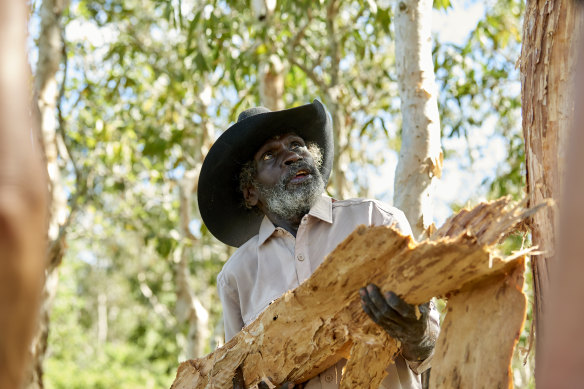
Frankie Guninyirrnyirr demonstrates different uses for stringybark.
Arnhem Land’s largest First Nations group, the Yolngu, are proud of their history and their continuing intense spiritual connection to their country, and eager to show it off to visitors.
Frankie Guninyirrnyirr shows us how his ancestors used to carve huge pieces of bark off the stringybark trees and burn them, seal them and fashion them into sturdy canoes to use on the Arafura Swamp, the largest marshland in Australia.
“We’d do this and then hunt magpie goose eggs, and the birds themselves,” he says in language, as he mimes each move with so much vigour and verve, an interpreter is barely needed. “Out hunting, we’d build platforms in the trees to sleep on to keep us safe from the wild animals.”
If this scene sounds familiar, it’s because it is. The 2006 movie Ten Canoes, the first Australian film ever to be made in Indigenous language, is the enthralling and multi-award-winning story of these people building their canoes and going on such a hunting trip. Narrated by the late David Gulpilil, and with one of its stars actually Frankie’s nephew Rico, it went on to the Cannes Film Festival where it won the coveted special jury prize at Un Certain Regard.
But that’s far from the only first. Arnhem Land was the site of one of the first guerilla warfare movements in Australia after white settlers tried to kill Indigenous locals to take over their land; the home of the first Aboriginal artists to win international recognition; and the location of the first land rights action and resultant legislation.
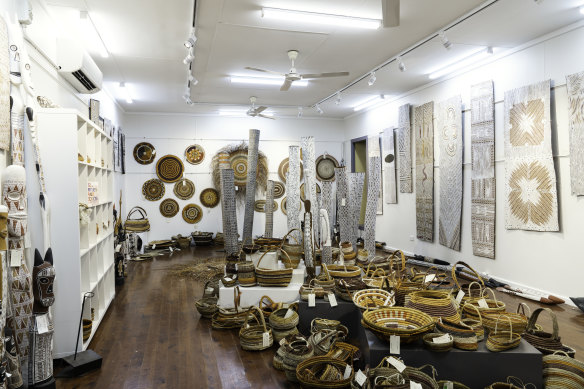
The Buku-Larrnggay Mulka Centre.Credit: Northern Territory Tourism
At the world-famous Buku-Larrnggay Mulka Art Centre in the nearby community of Yirrkala, a petition painted on bark peeled from the eucalypt stringybark trees is on display. This was one of a set presented to Federal Parliament in 1963 protesting against mining companies that didn’t consult with traditional owners before setting up on their land, and has just been given to the gallery.
“That’s something that changed history,” says anthropologist Professor Howard Morphy, who’s been visiting this centre and working with the Yolngu for more than 40 years. “The Land Rights Act wouldn’t have existed without the bark petition. It was the first time land rights went to court and ended up in the signing of a 100-year lease agreement in 1963 and changed everything forever more.”
It’s little wonder Frankie is so proud of the place.
How can you visit Arnhem Land?
All visitors have to apply for permits, and conditions are often quite strict about where you can go and what you can do. With so few places to stop on the road, and so few facilities and places to stay, most visitors choose to take an organised tour.
The only one in operation is run by Outback Spirit. It offers a 13-day trip from Nhulunbuy on the Gove Peninsula in the east – just under a two-hour flight from Cairns – to the Cobourg Peninsula in west Arnhem Land, flying back out to Darwin.
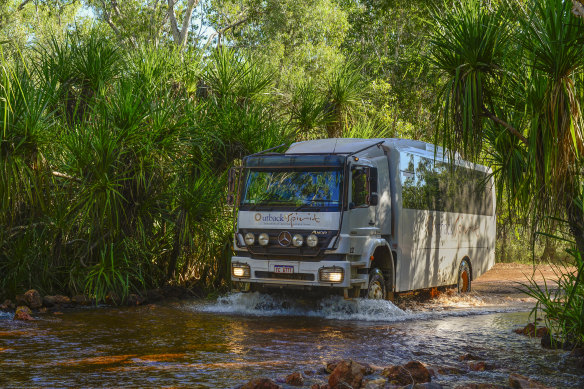
Outback Spirit is the only tourism operator in Arnhem Land.
“This is going to be one of the biggest adventures of your lives,” our guide-driver Greg Patterson assures us, once we’re all sitting in the rugged 26-seater all-weather Mercedes-Benz vehicle. It’s not always going to be comfortable, he says; sometimes it’ll involve long days of driving over incredibly uneven sand roads, through rivers, up banks and down creeks. There won’t be any shops, only a caravan-type toilet in the back of the bus, or the bush outside to relieve ourselves.
And that bush … filled with crocodiles, snakes, dingoes, all manner of nasty bugs and wild buffalo, cows and feral pigs. “The first-aid kit on board won’t be any match,” Patterson says in his laconic outback drawl, “for anyone who’s had their leg bitten off.”
But while this is Outback Spirit’s most ambitious trip, it’s also its most popular, with the highest passenger approval rating. The first time they attempted it in 2012, the truck became bogged in a river and passengers had to be airlifted out. The company tried to cancel the rest of the tour; their passengers refused to let them. “This is the most exciting adventure I’ve ever had,” one of them declared.
Nowadays, it’s a triumph of slick organisation, skilful driving, remarkably luxurious glamping accommodation and excellent food during the 1217-kilometre journey. This time, there’s 22 of us, all internationally well-travelled Australians who’ve decided that now is the time to explore this last wilderness of our own country. And we’re raring to go.
Into the interior
Everywhere we look, there’s evidence of smart Yolngu business sense accompanied by an enduring commitment to traditional culture. After buying supplies of the now also commercially produced Butjiringaning Healing Balm – made of those leaves at the welcome ceremony – we spot the site of the Garma Festival, Australia’s annual gathering of indigenous people that today is an important discussion place for policy.
Next, we pass a Yolngu-owned-and-operated mine on the outskirts of Nhulunbuy, then suddenly hit a large expanse of cleared land which marks the start of another locally owned venture, a cattle station, with about 10,000 head of cattle on 10,000 hectares.
And at odd intervals all along the Central Arnhem road, in between sightings of wallaroo, scrub bulls and wild buffalo wandering through the forests on either side, there are small “mosaic” burns of the undergrowth being undertaken by local rangers, according to the time-honoured conventions of caring for country.
This freedom to abide by their own lore, however, has been hard won by the Yolngu. As we rise up an escarpment before descending to the Arafura floodplains, in an area known as Murwangi, it’s painful to remember that these lands were once so coveted by whitefellas that in 1885 they set up a cattle property, the notorious Florida Station, driving out the locals.
When the Yolngu objected, the newcomers reacted with guns and guile. They bolted a swivel canon to the front deck of the homestead to kill any “visitors” and later gave the Indigenous inhabitants a “peace-offering” of horsemeat. It had been poisoned.
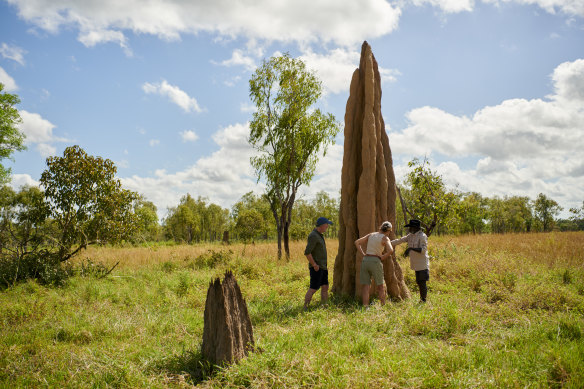
In parts of Arnhem Land, towering termite mounds are used as hot ovens.
The mass deaths sparked a guerilla war, fought with guns against spears and a thorough knowledge of country. By 1893, the station was finished.
Later, in 1903, another company came in to produce meat, employing roving gangs of armed men to shoot Aboriginal residents on sight. Again, the Yolngu fought back, and by 1908 the company quit. The Yolngu lost many battles, but they certainly won the war.
Undoubtedly, their knowledge of how to survive and thrive in a place that’s so inhospitable to newcomers stood them in good stead.
Frankie demonstrates local know-how: how pandanus leaves are stripped for the women to weave with; which trees’ leaves can be used to treat illnesses; and which are a perfect substitute for sandpaper. Then he hunkers down and paints a selection of ochre onto his arm until the striking image of a water monitor miraculously appears. It’s fair to say, we’re blown away.
We go on a boat for a trip around the 1300-square- kilometre Arafura Swamp too, the largest freshwater system in the country, drifting around the waters, peering into the woodlands and wetlands to spot crocodile as catfish, barramundi and tarpon breaking the water surface all around us. Above our heads are 220 species of bird and we’re rewarded by a cloud of magpie geese, an Australasian darter or snakebird, curlews, whistling dove, green pygmy geese, egrets, black-necked storks and barking owls.
Those owls are not quite so admired at 5am the next morning, though, when they wake us with a cacophony that sounds like a dogfight right by our beds.
Isolation breeds invention
We’re now heading further west, past towering termite mounds, to Ramingining, a small community of around 900 Yolngu. “There’s not a whole lot of untouched parts of the world left, but you’re definitely in one right now,” Paterson tells us.
But isolation seems to breed invention. The hard ironwood trees are used to make clapsticks, spears and spear-throwers. The tough seeds of the pandanus tree are ground into grain. The termite mounds are used as hot ovens.
And, deliciously, the pesky green ants that leap on you and bite when you brush past trees are harvested to make lemony desserts, to soothe sore throats when there’s too much singing in ceremonies and, most fabulously of all, turned into citrus-tanged gin.
Ramingining also has one of the most gorgeous arts centres in Australia. Set up and managed by the local people, the Bula’bula Arts Centre contains a small museum dedicated to Ten Canoes and an amazing array of artworks, many featuring that totem magpie geese, with artists painting in front of visitors. As your eyes blur with the tiny intricate patterns, you can’t help admiring how still and deft the artists’ hands are.
“We paint our stories,” says Andrew Wanamilil, sitting on the ground before his latest artwork, which he’s sold even before it’s finished. “We can’t paint anything else, only what comes to us. These stories are a continuation of our culture.”
Next, we drive through the fast-flowing Blyth and Cadell Rivers, and past all the tiny dirt turn-offs to outstations where many of the local Indigenous population now live, to the town of Maningrida.
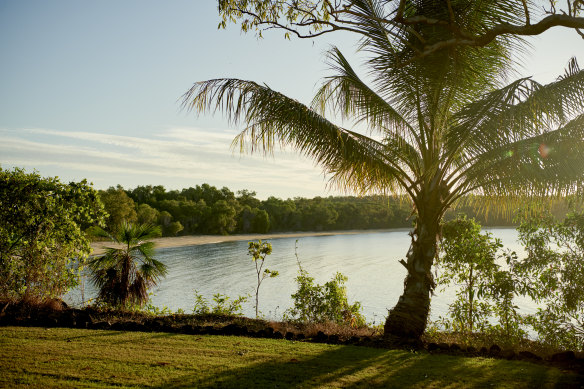
The Outback Spirit tour finishes with a stay at five-star Seven Spirit Bay Lodge.
This area, with so many waterways, including the Liverpool and Tomkinson rivers, is well known for its fishing, for its giant barramundi, trevally and cod. It’s a stunning setting, with birds, butterflies and crocodiles lazily snapping at both from the muddy banks. I even catch a small barra but, as I haul it in, it sneakily darts off the line. Everyone else is much luckier – or more skilful.
The region’s also known as one of the most linguistically diverse areas in the world, with 12 different language groups in the area, and most people speaking at least four, usually five, languages, and understanding more.
It has its own arts and culture centre, too, full of beautifully carved “ghost spirits”, fibre sculptures, paintings and some of the most exquisite weaving in Australia, of baskets, string bags, mats and dilly bags. Doreen Jinggarrabarra is a leading fibre artist, and demonstrates how she uses pandanus and jungle vines for her work. “I learnt from watching my mother,” she tells us. “This is the traditional way. We love to do this. We want to keep our culture alive.”
Ancient landscapes, historic rock art
That culture certainly has a very long tradition. Now entering the stone country of west Arnhem Land, we’re in an ancient open-air art gallery, an area that has the greatest concentration of rock art in Australia, if not the world.
This region at Mount Borradaile is a sacred site inside a 700-square-kilometre area of rocky overhangs and catacombs formed about 600 million years ago. But it contains no fossils; incredible to realise that it predates multi-cellular life.
Its masterpiece is a massive 6.1-metre-long rainbow serpent, painted in red ochre over white, with vicious-looking crocodile teeth, horns behind its head and fins on its side – the largest serpent drawing in the country.
There are rock paintings everywhere we look here, of hands, of hunting scenes, of animals, birds and fish. Traditional Bunij owner Charlie Mungulda gave permission for small groups of whitefellas to be allowed to come and view the images, potentially up to 50,000 years old.
Indigenous life has an incredibly long history in Arnhem Land, and it feels an absolute privilege to be given a glimpse of it, as well as of its assured future.
The details
FLY
Qantas flies from Cairns to Nhulunbuy daily. See qantas.com.au
Outback Spirit has its own aircraft that fly from the Cobourg Peninsula to Darwin. See outbackspirittours.com.au
TOUR
Small group tours, with a maximum of 22 people, take place regularly through the dry season, May to October, with the fare including all travel, meals, selected alcohol, morning and afternoon teas, all fees and permits, and accommodation in a lodge at Nhulunbuy and then luxury glamping at all the other two-night stops, finishing with a three-night stay at the five-star Seven Spirit Lodge, and an overnight stay in Darwin. From $14,495 a person twin-share.
Five more things to see and do in Arnhem Land
- Explore Nhulunbuy, the well-kept town on the Gove Peninsula, founded in the 1960s after the discovery of bauxite, and climb up its lookout for the panoramic views of the coastline, the wetlands and the Rio Tinto mine.
- Visit the Djomi Museum in Maningrida, a real gem of a place, with more than 1,000 works of art – one of the largest community-held collections in the Northern Territory. The Djomi is a mermaid of local legend, a symbol of women’s fertility, and exhibits include weapons, musical instruments, tools, jewellery and ceremonial outfits.
- Take a boat trip over the wetlands of the Cooper Creek under the shade of Mount Borradaile, watching brolgas dance, eagles soar and massive crocodiles sun themselves on the banks.
- Marvel at the (misplaced) courage of the Australian navy who tried to establish a settlement in 1838 on the remote Cobourg Peninsula as the first line of defence against possible invaders. After numerous deaths from disease and crippling sickness, it had to be abandoned after only 11 years but the ruins of the Victoria Settlement are incredibly atmospheric.
- Go fishing from Seven Spirit Bay, the luxury fishing lodge also on the Cobourg Peninsula. It’s famed for its giant barramundi, trevally and mulloway.
The writer travelled as a guest of Outback Spirit.